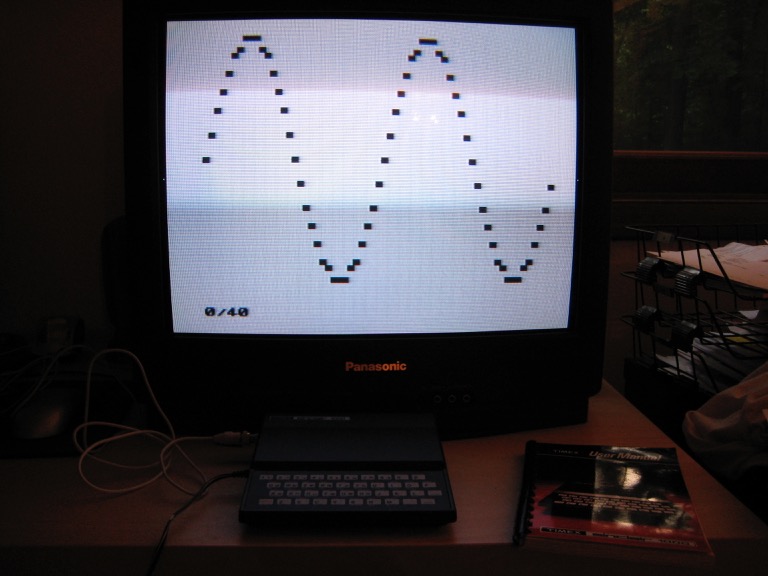OLPC XO First Impressions

It's a little slower than I was expecting (not that I was expecting it to be swift or anything), and the soft keyboard takes a little getting used to, but on the whole I'm liking it. The industrial design is great in my opinion, and has some neat little touch: the texturing in the case has large nobbles, and around the handle the nobbles become Xs, so that the texturing repeats the XO logo. The Sugar UI feels good and the included apps, a.k.a. Activities, provide a good cross section of functionality, from word processing to recording video on the built-in camera.
The browser, which is Firefox derived, works well and even has some Flash support (via Gnash). It also has some integration with Sugar, since when I went to upload a photo to Flickr and hit the Browse button, a popup appeared showing my last few activities, including the picture I had taken. When I clicked on it, it inserted a /tmp path to a JPEG file into the form. Alas, when I hit the Ok button Flickr told me that the file was empty. I popped into the shell and could the file in question was indeed empty, but there was a non-empty JPG also in temp. I copied it to the path the browser was pointing at (I couldn't get it to let me edit he path in the browser for some reason), and this time the upload worked. I'm sure that's either just a kink or something I didn't do properly when saving the photo.
My MacBook looking at the XO:
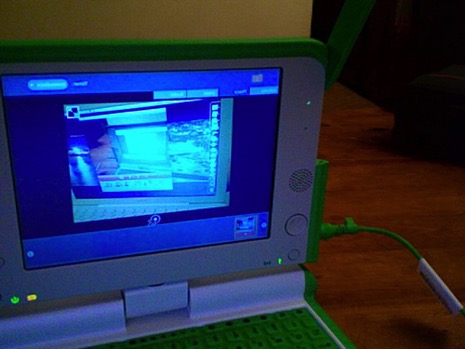
My XO looking at my MacBook (the photo referred to above):

The Neighborhood page in Sugar showed my home wireless network's SSID, but I couldn't figure out how to connect to it. I have since found out that you just need to click on the dot representing the network, but I expected there to be a "Connect..." option in the popup dialog that appears when you hover the mouse over the dot. In any case I use WPA and, at least according to the OLPC "getting connected" page, "we do not support WPA-enabled WiFi access points; we anticipate including WPA support in early 2008." However, I did some googling and found that I could drop to the shell to get WPA working (see http://wiki.laptop.org/go/WPA_Manual_Setting). I created the script suggested, ran it, and rebooted the XO, and it came up on my WPA network.
Some of the Activities require more than one XO. Fortunately, one of my colleagues at work ordered an XO the day after me, so his ought to be here soon. I'd particularly like to try out the Distance Activity,

which can measure the distance between two laptops by measuring the length of time it takes for sound to travel between them, but since it requires 2 XOs, it'll have to wait until we both can get them into the office after the holidays.
For more photos of the XO, see the unboxing set I put on Flickr.
BugLabs Beta Now Open
BugLabs update
We did get an update from Jeremy (the marketing guy) update the beta program back on November 20th:
Hi there - we know that it's gotten a little quiet around here and we want to apologize. We also want to give you an update (overdue!) so you don't think something is amiss.
First - BIG thanks to everyone whose been involved in our beta program. We've learned a ton from you and are applying it to our software and hardware. We would not be where we are right now without you. Please keep pounding. There's more fun stuff on the way.
Second, when we initiated this beta program we got a great response from everyone - applicants, selected testers, etc. Many people jumped in and started exploring, coding and building things. Others hung back and waited to see what unfolded. And the truth is, not very many did. It became clear to us pretty quickly that we were asking a lot of you. Without hardware to play with and more module types to mash up, folks ran out of energy. We intended to get more resources into the mix but we weren't able to because everyone's working hard on getting product out the door. Since then we've been hiring and I'm happy to say we will be making hardware available soon too!
We are a few defects away from moving out of closed beta and into an open beta of the BUG SDK and BUGnet. And as I mentioned above, our hardware is fully up and operational (although we can't say there's no defects just yet!). Needless to say, we're pretty excited about getting to this point!
In December, we'll be bringing the first batch of BUGbases and BUGmodules to market. These initial BUGbase units will be limited production v0.9 hardware. We're giving them that designation for a couple reasons. We decided to change the design of the front panel a little bit and will not be able to get that change into these first units before the end of the year. Same thing for the wifi chip set. We will not be able to incorporate our new wifi design into BUGbase before year end. So rather than delay shipment, we've decided to go into limited production. These units are functionally identical to what our final production units will be (with the only exception being wifi). All our BUGmodules will be v1.0 production and will be fully compatible with both our limited production and full production BUGbases.
Between now and the open beta, you are welcome to continue to use BUGnet, the SDK, and participate in the forums. There will be at least one update to the SDK in the meantime. As we have reached this great milestone, we invited some of our blogger friends to come take a look at working hardware, here's a few videos (Gizmodo, TechCrunch, Silicon Alley Insider) that show it off. If any of you'd like to come by the office, please let us know, we'd love to meet you in person. For those of you in the SF Bay Area, we're having a meetup on November 29th and we hope you can stop by!
Thanks again,
Jeremy
I asked a couple of follow-up questions (sorry for the image c&p):
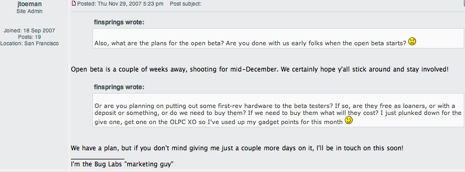
I'll post back when he lets us know what the plan is. They demoed some units running Qtopia to the press, but not anything running within the BUG framework. It's going to be interesting to see how the BUG SDK fits into the rest of the device's infrastructure.
SuperDuper for Leopard almost here
I'm looking forward to the update. SuperDuper! has always been my backup solution for OS X and I've been feeling itchy running on Leopard without it; I've got Time Machine running, but you have to restore from a boot CD with that if things go awry - yuk. I'm particularly nervous for my PowerMac, since it's boot volume is on the same 3+ year-old 120GB drive in it that it came with. I really ought to pick up a new ATA drive for it before it goes belly up.
Playing with the OLPC XO Emulator
I downloaded Q.app and a recent build of the XO emulator disk image -
olpc-redhat-stream-development-build-542-20070801_0412-devel_ext3.img and configured a VM as per the instructions on the OLPCWiki. It started up first time, asked me for my name and I was in. Here's a view of the main page:
I didn't mess around with the emulator's DPI settings as suggested, so it looked a little fuzzier than the real thing would. Paint wouldn't start for me, but the word processor, chat program, browser, and other things I tried did. Some, like the chat program and connect 4 game needed other XO users to be in your neighbourhood, and for some strange reason there wasn't anyone else running the XO emulator on my rural street at 2am; weird huh?
I'm excited for it to arrive. I wish I could have gotten a couple to be able to have them talk to each other, but I was pushing my luck getting one, never mind two. One of the guys at work is thinking about getting one as part of the Give One Get One program. I'll have to try and persuade him so our XOs have someone to play with.
One Laptop Per Child: Give One Get One
I ordered mine today. Even though I don't use my laptop at Starbucks that much, I'll get some use out of the HotSpot service and I would really like to see OLPC get off the ground and do well. There's some truly innovative technology in there - see David Pogue's video for more details - and it's all good old-fashioned open source. How could I say no?
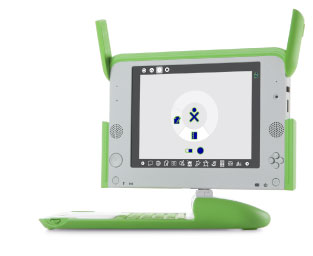
Theme Change

BugLabs: Location-Aware To-do List Manager
I'm trying to do my part anyway (this is fun for me) and so I posted the fifth community app tonight. I found time last night to put together a first pass at a location-aware to-do list manager application and cleaned up the GUI some tonight. It's far from pretty, but it has several (canned for now) to-do lists, each with a name, related location and list of items. On the VirtualBUG's LCD modules, it looks like this for now:
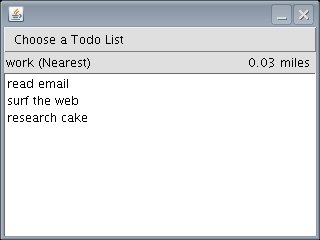
("Choose a Todo List" is a menu)
Once you've plugged the LCD and GPS modules into the bug, it will by default show you the to-do list whose location is nearest to your current position. I made it so that you could also explicitly select a list from a menu though. I posted it as-is, but I need to come up with a way of actually creating and working with lists. The bug doesn't have a keyboard, but an on-screen one could be created, iPhone-style. I've also considered exposing the lists via a servlet, but that would only be helpful if you had a 'real' computer to-hand; ideally you could work with lists directly on the bug. Another possibility in the less-than-ideal camp is to make it sync with web-based to-do list sites such as Remember The Milk or Ta Da Lists. I posted my thoughts on the forum, so I'll see what the buglabs folks and the other beta-testers think before going much further. I certainly don't fancy trying to create the on-screen keyboard myself in PhoneME's AWT.
BugLabs t-shirt

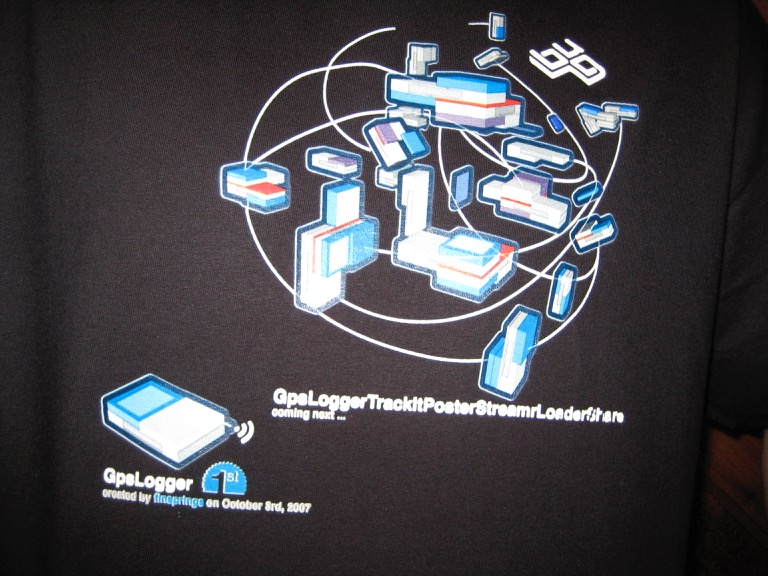
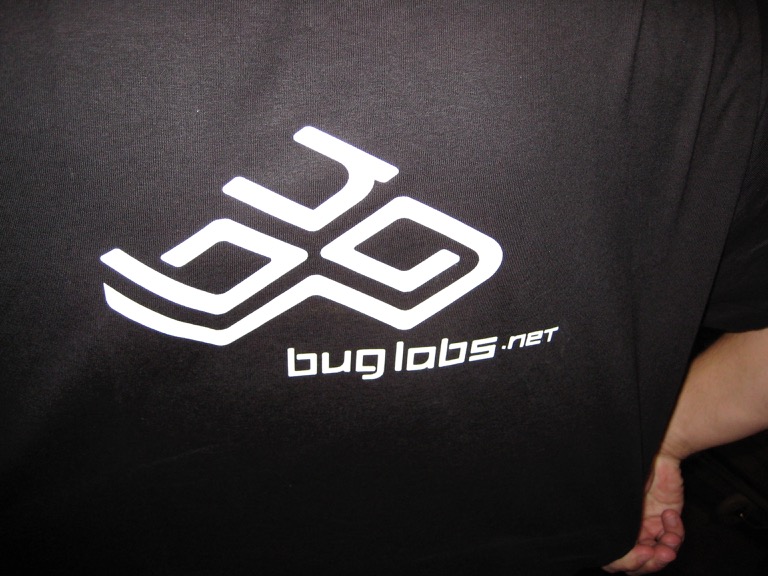
BugLabs: Pictures of the real thing
I noticed tonight that one of the press images, which is labelled "Community Applications Image", is the one that they used on the t-shirt they sent me, and it includes the name of the first app that I posted: GpsLogger (which still doesn't log; I ought to get on that, huh).


TaskPaper: a to-do app for the rest of us?
At first glance, TaskPaper seemed just too simple. But when I actually started using it, I found that its simplicity was exactly what I needed. It's like a piece of paper with fring benefits. The simple syntax->format mechanism fits my programmer brain, and the fact that I can make up my own structure in a document without the application getting in my way is priceless. That's what always ended up putting me off the fuller featured apps in the end, and it's what ultimately sold me on TaskPaper.
To define a project, you type in the name of the project followed by a colon. That's it. TaskPaper turns what you've just type into a nice title. Within a project you can create to-do items by typing a dash as the first non-whitespace character on a line. It doesn't force that dash to be at the left margin though, so you can create simple subtask structure without any fuss. It doesn't do rollup of those subtasks, but then why does it need to?
So if you type:
Shopping:
- eggs
- milk
- cake
- more cake
Home:
- eat cake
- eat more cake
you will end up with:
Easy! If you notice, there's a tab there at the top that says Home. That means it's showing you your entire todo document. You can type a search into the search and it will instantly restrict your view to the matching entries. For example, here's the view when I search for cake:
So you can still see your projects, but only the important, cake-related entries within.
You can also click on a project title to focus on that project:
You can also open multiple tabs on the same document:
So you can see, it's pretty easy to get around in your to-dos. Once you find something you need to do, and then you actually go and do it, you can mark it as done by either clicking the circle in the margin or placing your cursor somewhere on the line and pressing Cmd-D. Here I only have more cake to finish my lists:
You will notice that "@done" appears in gray on a task that you have marked as complete. This hints at another feature of Taskpaper: tagging. You can tag items by prefixing the tag name with an ampersand. Here I'm trying to offset some of that cake:
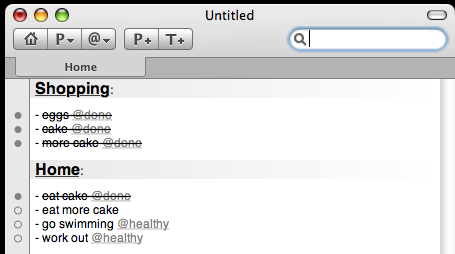
And, like projects, and arbitrary text, you can also filter based on tags. TaskPaper even builds a drop-down list of them for you automatically:
So it actually does a fair bit more than you might expect, but just as importantly, it doesn't try to do too much. There's a 15-day trial, and if you like it it's $18.95 so I'd recommend giving it a go.
BugLabs: New SDK
One of the other beta testers, koolatron, took the simple GpsLogger app I pushed out and came up with a much nicer version, complete with a properly centered google tile and button-based zooming. I haven't had much time to spend on the Bug, between the release march at work and DIY stuff at home. I'm looking forward to messing around with it again, but it probably won't be this week.
Oh, I got a very nice email from the BugLabs marketing guy Jeremy:
Dave,
Just wanted to let you know your first prize is coming at ya. Please know it might show up in a fairly generic package, but it's unique and we spent a lot of time making something we thought had the right amount of personal touch. Hope you receive it as fondly as we sent it, and please let me know when it arrives - sometime next week I believe.
Best,
Jeremy
I'll post back when it arrives.
BugLabs: Second App "BUGer"
Hi, Now that you've had some time playing around in a fairly open context, we'd like to try a structured project where everyone is working on the same task, and see how the results play out.
The first project is to use the BUGbase and the motion detector module to build a home security system. This is a pretty straightforward project (in our estimation) and shouldn't take too long if you're already up to speed on the platform. For those of you new to the environment, it should be a good way to learn the basics of BUG.
Here's the "specifications" of the home security system: On any detected motion, the system should log an alert with the current date/time stamp. The alert log should be accessible via a Web interface.
Yup, it's that basic. For a little extra help, here are the basic steps to build the system: 1. Create a new BUG application, in the creation wizard select the IMotionSubject service.
2. Register a listener for callbacks to when motion is detected. Create and append to a file and log the date and time of occurence.
3. Create a menu item for the application that allows for the logging to be turned on and off.
4. Create a servlet that retrieves the log data from the log file and presents it to a web client.
5. Confirm that your application works by triggering motion events from the command line.
Once you are done, upload the app to BUGnet. If you need any help with the project, please let us know.
We also have a few ideas for those of you who want to push your app "to 11" (although you can be as creative as you want!), here are some of ours: * When an event happens, send an SMS * Send an email report at the end of every day * Double gold star project: also integrate with the camera, and make a picture available with each event. * something else???
Thanks, we'd love to see this wrapped up in a week if possible!
Best,
Jeremy
_________________
I'm the Bug Labs "marketing guy"
I had a bit of spare time on Sunday night so I put together "BUGer" that does pretty much what Jeremy was asking for. I added in the camera stuff too, so BUGer takes a picture on each motion event. However the servlet container in the VirtualBUG doesn't yet support static resources, so the image can't be displayed on the webpage. It's there for when it can though. If I find time I may look at putting in the email part, but the PhoneME JME doesn't have email stuff in it that I could see, and scraping SMTP seems tedious, so I may not. I'm also not sure how you would do SMS unless you did it as email-to-your-cell-phone, which is just email from the BUG's perspective, since the SMS part is done by the carrier's email server.
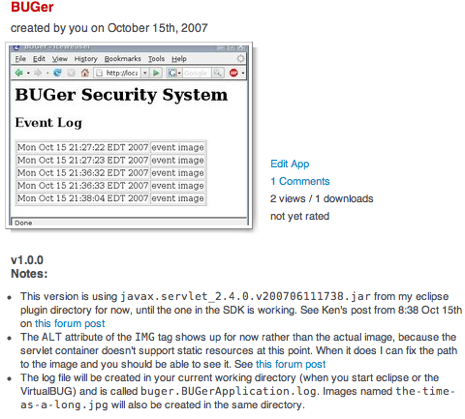
BugLabs: My first app came first...and last
One of the other testers is working on a new and improved version of my GpsLogger application. I'm looking forward to seeing what he comes up with. I bumped my version to 1.0.3 last night after factoring out the utility classes to a separate package and doing some general cleanup and documentation. I'm thinking about doing some webcam stuff with it next. There's a sample app that posts images to Flickr, but I'd like to do it more like a regular webcam. It would be pretty cool to update a picture every few minutes while you're out and about (assuming of course you have municipal WiFi...).
BugLabs: My GpsLogger gets slightly less lame
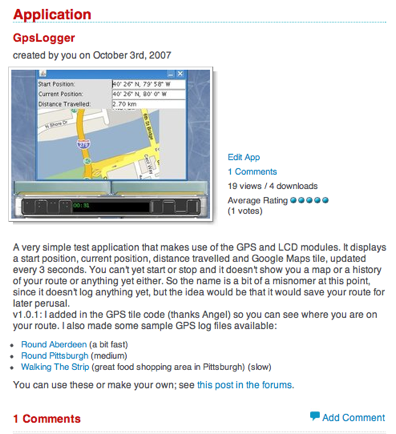 b
bBugLabs New Rendering
USENET Nostalgia
Newsgroups: misc.forsale
From: d...@dcs.ed.ac.uk (David Findlay)
Date: 29 Jan 93 13:47:31 GMT
Local: Fri, Jan 29 1993 9:47 am
Subject: Sega Game Gear For Sale
I have a 7 month old Sega Game Gear for sale (I got a SNES you see).
It comes with the following :
6 games, TV adapter (turns it into a portable colour TV), AC adapter, rechargeable battery pack, car lighter adapter,
carry case for all the above + all instruction booklets, manuals and receipt for remainder of guarantee.
All this stuff cost me about 400 pounds so I will let it go for 250 ono (inc p+p).
Please e-mail me with offers.
and:
Newsgroups: alt.fan.ren-and-stimpy
From: d...@dcs.ed.ac.uk (David Findlay)
Date: 3 Feb 93 14:07:24 GMT
Local: Wed, Feb 3 1993 10:07 am
Subject: R&S in the UK
Can anyone tell me if Ren and STimpy stuff is available in the UK?
My girlfriend is from Pennsylvania and I saw the specials on MTV there at Christmas, but I've never seen anything about them at home.
I'm very happy to say that my girlfriend back then is my now my wife and has been for 13 years!
This also reminds me that I sent a VHS tape to some guy in England with a tenner 'cos he said he'd tape some Ren and Stimpy episodes for me (I was eager to swot up to impress my girlfriend). He never returned it, but on the plus side I did find the lyrics to the log song on archie...
"VOCOLLECT HEALTHCARE SYSTEMS LAUNCHES ACCUNURSE® VERSION 2.0" Press Release
Here's a picture of me with our new AccuNurse Voice Assistant (hastily taken with PhotoBooth, so excuse the backlighting):
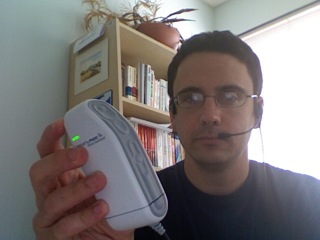
It looks a bit big in that picture because of the perspective, but it's actually pretty darn small.
BugLabs Update: My first app
They had their first webinar with the beta testers on Thursday, but we're in the final throes of getting a release completed at work, so I couldn't attend. They've also initiated an application cook-off where they judge tester-created applications and award some prizes. I doubt my humble offering will make it too far in the process, but it was at least the first user-generated app uploaded to the site.
Right, I best be off for now; gotta remote into a customer site and do an upgrade soon. I'll leave you with the entry for my first app:
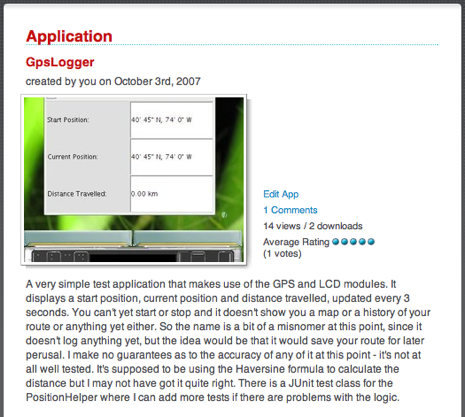
Getting your pictures from Flickr into iPhoto
Once you have iPhoto and Flick in sync, you can import new photos from your camera into iPhoto and then export to iPhoto using FlickrExport and they will stay in sync. Of course you may have no interest in getting your photos from Flickr to iPhoto, in which case feel free to stop reading. In my case, while I had the photos around, they were in multiple folders on my hard drive and didn't have any tags associated with them. On Flickr I had them tagged, dates corrected, and so on. Rather than recreate that process I decided it would be easiest to take what I'd done in Flickr and push it to iPhoto.
The linked AppleScripts below were mostly what I used to accomplish this process, again in conjunction with the XML files from the script mentioned in Backing up your Flickr photo info. Now some caveats: I had never used AppleScript before when I wrote these, and my copy of AppleScript: The Definitive Guide was still in the mail. If you know AppleScript you will be aware of how quite unlike most other scripting languages it is. The scripts below are undoubtedly not in best AppleScript style, and I didn't spend any time modularizing them, so you'll see common functions in each for XML parsing and so forth.
So with that said, take them for what they are and do with them what you please. Hopefully between them they'll give you enough to make a start on whatever iPhoto library-munging project you've decided to take on.
Breaking the 32MB barrier on Windows (pre-6) CE
In Windows CE 6, the limit was raised to 2GB, so you have much more breathing room (you are limited to 512MB of physical RAM, but still, what luxury).
So, what do you do if you're developing for pre-6 Windows CE and you run out of heap space for your application? Well, you can play some tricks with DLL load ordering, but that only gets you so far. One neat trick I rely on is what I like to call the 'LMA incantation'. It goes like this:
If you ask for at least 2MB, and you ask for it in a particular way, then CE will allocate that memory for you from the Large Memory Area. This is the area of memory above where the individual 32MB slots exist for normal processes. It's normally used for memory-mapped files (which is another way you can make use of the LMA if you need to).
Here's the incantation:
DWORD size = 2*1024*1024; // (or more)
void *p = VirtualAlloc(0, size, MEM_RESERVE, PAGE_NOACCESS);
p = VirtualAlloc(p, size, MEM_COMMIT, PAGE_READWRITE);
// optional:
#define LMA_START_ADDRESS (0x42000000)
assert(ptr > LMA_START_ADDRESS)Now if you do this in one line rather than two, that is do the commit without the reserve, then you will get memory from your process' 32MB slot rather than the LMA, and the assert will of course fail.
This one has saved my behind on more than one project. Enjoy!
Notes:
- From the MSDN description of VirtualAlloc:
In Windows CE 5.01 and earlier versions, if you call VirtualAlloc with dwSize >= 2 MB, flAllocationType set to MEM_RESERVE, and flProtect set to PAGE_NOACCESS, it automatically reserves memory at the shared memory region. This preserves per-process virtual memory.... Since CE 6.0, irrespective of the value of dwSize, kernel will always try to allocate VM in user process space. Also, user applications cannot call VirtualAlloc with shared heap address range (0x70000000 - 0x7fffffff) since this is read only for user applications and read/write for kernel mode threads.
- A recent article from CE whiz Doug Boling on CE memory architecture.
BugLabs Beta is a go!
We're not under a formal NDA or anything, but we've been asked not to disclose URLs for the various components of the beta program, and so on, which is fair enough:
They have bug tracking, forums and a WiKi already up and running, and they made an SDK available. The SDK includes VirtualBug: an emulator for the hardware, since hardware isn't available at this stage.By the way, please keep these links to yourself, they should all be considered confidential to the beta program. You are welcome to blog about, chat about, Twitter about, text about, email about, or send smoke signals about the beta program, but please don't share the links or SDK.

They built their SDK on top of Eclipse and I have to say it's pretty slick for things being so early. The instructions to get everything up and running are also unusually polished for a beta program.
There are a few sample applications that do real things, like post pictures to Flickr with geo-tagging. Some things are still necessarily in the mock-up stage until the hardware is ready, like the camera module (which pulls pictures from file rather than an actual camera) and the motion sensor (which 'detects' motion by you typing the word 'motion' into the Eclipse console).
Still, I'm very impressed at how it looks at this point. The few questions I've had have been replied to promptly in the forums and the folks at BugLabs all seem very helpful.
I'm still getting my feet wet in the SDKs, but I'll post updates as I make progress.
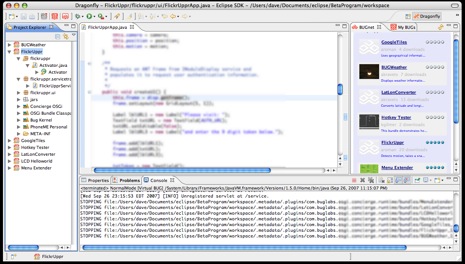
Stephen Fry is a geek
His first post is all about smart phones. Let's hope he keeps it going. I for one am already subscribed to his feed.;
vmware spamming me; sneakemail saves the day
I'm surprised, and a little disappointed, that a company of VMware's stature would let their mailing lists get abused like this though.
More C++0x fun
OnSoftware Video Podcast

OnSoftware is putting out some pretty neat video podcasts right now. As a (predominately) C++ guy, I found the ones with Bjarne Stroustrup, Herb Sutter and Scott Meyers to be particularly interesting.
They're making me eager for C++0x to get here! I realize it's going to be a while though: to my knowledge, Microsoft still haven't said when Visual C++ will have TR1 support, never mind C++0x. I can live with getting my
shared_ptr fix from the the Boost libraries for now, but having shared pointers fully and officially in the language, along with things like lambda functions, will certainly make life easier.Note that you can get TR1 now from Dinkumware, and they'll likely be first to put out proper C++0x support once it's ratified (fingers crossed for 2009). P.J. Plauger and Pete Becker are very nice to deal. Indeed, we used Dinkumware on Windows CE 4.2 so that we could make use of streams. Unfortunately for our application, it's tough to justify the overhead of an alternate library, and we had problems on other people's devices that exported C++ APIs in their SDKs (they would export a function that returned a Microsoft
std::wstring for example, which isn't binary compatible with a Dinkumware std::wstring so we'd end up wrapping their SDK in C: very ugly).Calling CYpress-5
I researched our exchange and found at Telephone World that it used to be called CYpress-5, so I printed up a little label using the 1942 report font, since it seemed fitting (well the 500 was introduced in 1949, and the coiled cable version is newer, but let's not split hairs).
Then, I'm ashamed to say, I had to find instructions on getting the finger wheel off to replace the label. Luckily, I found just what I was looking for at porticus.org.
The phone looks great, and it sounds fantastic: the bell could wake the dead, and really brings me back to the beige British Telecom equivalent we had when I was growing up. Best of all was my daughter's reaction to it, and walking her through the use of the rotary dial.

Parallels and Linux: 512MB is your lot
I'm running Slackware 12.0 in a Parallels VM with a vanilla 2.6.21.5 kernel. If I assigned that VM 512MB of RAM it runs just fine. If I give it 768MB or 1024MB, modprobe crashes on startup. Set it back to 512MB and it's happy again. I've seen other people have similar issues trying to get Parallels to run the server version of Ubuntu.
Parallels doesn't have this restriction with a Windows XP VM, so it has to be something they aren't emulating correctly for Linux. It makes me wonder if I ought to have waited for VMWare Fusion, as I use VMWare Workstation at the office a lot, but the beta wasn't even out when I bought Parallels. Ah well,
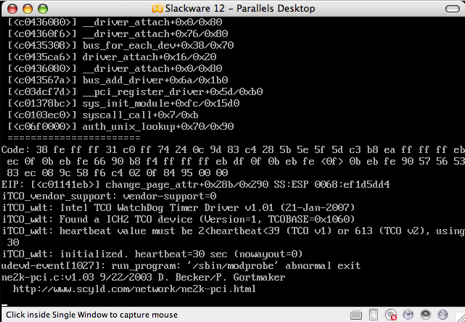
Putting the S back into SSH
SSH Public Key Authentication
Back in the day we all used TELNET to connect to our servers. This was fine until bad people came along. TELNET sends your username and password in the clear, and so bad people started watching packets fly past and grabbed your account information out of the air. And then came Secure Shell, or SSH, which uses secure sockets technology to encrypt the connection between your client and server machines. No more password grabbing.
By default you use SSH pretty much like TELNET, where you specify your username and password every time you connect. However, SSH also supports public key authentication, which allows you to securely not have to enter your username and password every time you connect. Yes, this sounds counterintuitive but it's true.
What follows is a super-quick how-to. If you want more specifics check out Dave Aaldering's SSH with Keys HOWTO or the various man pages for ssh (try man -k ssh to see what man pages your system has for SSH).
To configure anything for SSH you need to create SSH's configuration directory, if you don't already have it. On your client and server:
mkdir ~/.ssh
chmod 700 ~/.ssh
The chmod is so only your user account has access to the SSH configuration directory. That's important. Once you have done that, you can proceed to creating your key. On your client:
cd ~/.ssh
ssh-keygen -t dsa
Accept all the defaults and specify a blank keyphrase when asked. You can include a passphrase, in which case the server will prompt you for this passphrase each time you connect. I'm assuming you want to skip that step, but feel free to specify a passphrase if you wish. The advantage is not specifying one is convenience. The disadvantage is that anyone with access to the console on your client machine will be able to access your server without a password.
You should now have a public key in ~/.ssh/id_dsa.pub and a private key at ~/.ssh/id_dsa. The public key needs to go on your server. The private key needs to stay where it is (this is what identifies you to the server and lets you log in without needing to specify a password). You may want to backup the private key file, since if you lose it you'll have to go through these steps all over again.
Transfer your newly-created ~/.ssh/id_dsa.pub public key file to the same directory on your server. Then on your server:
cd ~/.ssh
cat id_dsa.pub >> authorized_keys
chmod 600 authorized_keys
rm id_dsa.pub
This tells the SSH daemon on your server that you authorize clients that know the private key that goes with this public key. The >> appends to authorized_keys if it already exists: you authorize as many clients as you wish (one for your laptop, one for your home desktop machine, etc.).
Now that you've told the server it's okay for your client to connect using a key, try it out. On your client:
ssh server-username@server-ip
You should be logged in without being prompted for a password! If not, make sure that ~/.ssh has permissions of 700 and ~/.ssh/authorized_keys is 600. You may also need to tweak your server's SSH daemon configuration file. It's usually at /etc/sshd_config and the entry you want is PubkeyAuthentication yes.
Once you have it working, if you want to disable log ins with a password, so that you can only do it with your key, set PasswordAuthentication in /etc/sshd_config to no. Be sure you don't lose that private key once you've done this though!
Extra Credit
If your username is different on your client than on your server then create ~/.ssh/config on your client and add an entry like the following:Server server-name-or-ip
User your-server-username
You can also add Port and Hostname entries for your server which can be convenient if you want to refer to the host by a different name when connecting (or if it a name if it doesn't have a DNS entry), or if the port is not the usual 22 and you don't want to remember to have to use the -p option to the ssh command. See man ssh_config for all the details.
Linux MCE: wow
There are higher resolution versions in
WMV and OGM formats available via torrents from the Wiki downloads page. I downloaded the DVD ISO to play with it on my P4 linux box, but after the 2 and a half day download it failed the MD5 check. I burned it to a DVD+RW anyway, trying to be optimistic, but it failed a CRC check while untarring something. Oh well; I'll keep an eye on it and try downloading it again some other time. It's based on Kubuntu and integrated MythTV for PVR functionality. I've run a Myth box before but had some stability issues with it, so I'll be curious to see if things have gotten any better.The new Fiire Chief gyroscopic remote control from Fiire that's featured in the video looks like a winner, but at $149 it's a bit out of my mad-money range for right now.

Correct dates on Flickr photos
YYMMDD_n.JPG format, so I knew there had to be a way to fix their dates programmatically.Starting from the python script I had previously written to archive my photo tagging information (see this post), I just had to add a function that used a regular expression to parse the date information out of the photos' filenames and call
photos.set_Data in the Flickr API. The function is up on TextMate's pastie site for those interested.iPhoto 7 first impressions
Events
When the main window appeared I was presented with a surprisingly small number of the much-touted Events. On closer inspection it seems that Events, at least from an upgrade, are pretty-much synonymous with the old Rolls, albeit given equal billing with Photos in the sidebar and a very pretty facelift. This was a little disappointing. I had understood that events were created based on their date taken, not the date they were imported into iPhoto (who cares about that date). I often batch import several days worth of pictures. Of course iPhoto will let you split an event, but the whole point of Steve's pitch was that you didn't have to do it manually. What made this more disappointing was the 3000 or so pictures I imported when I switched; these all showed up as 1 event spanning multiple years.
Since I didn't feel like splitting that mega-event up, I decided to create events from the albums I had created. This proved to be a little clumsy, but perhaps I just didn't find the simplest way to do it.
For each album, I:
- Selected the album in the side bar.
- Selected all the photos.
- Picked Create Event... from the Events menu.
- Accepted the warning about photos only being in one event at a time. (which can silence after the first time)
This created an event. I could tell because the count after "Events" in the sidebar went up by one, but it left me with my pictures selected back in the album. I then had to:
- Click Events in the sidebar.
- Find the new Event (which fortunately was selected).
- Edit the title of the new event and pick my key photo.
Moving forward this shouldn't be so tedious, but had iPhoto created events based on the date each photo was shot, I think it wouldn't have giving me a better starting point.
Tags
I use the excellent FlickrExporter to public my photos to my Flickr account (Fraser has updated it to use the new official Apple API in iPhoto 7 by the way). One of the many nice things about FlickrExporter is that it turns iPhoto keywords into Flickr tags. However, getting keywords added to photos in iPhoto 6 was a pretty tortuous experience; or it was until I discovered Ken Ferry's Keyword Assistant. With Keyword Assitant I just wouldn't have been able to contemplate keeping my tagging up-to-date. A few days ago, Ken posted on the Keyword Assistant blog:
And boy was he right. If you enable viewing of keywords in iPhoto 7, you can simply click in the space where the keywords are (or would be if there aren't any yet) and start typing. And I mean right under the photo in the main Photos view, not in the information popup in the sidebar. The keywords tab-complete, and you can use comma to accept one and start adding another, just like Mail does with contacts when you're addressing an email. Same goes for the photo's title: click on it and start typing.I'm happy to report that I won't be updating Keyword Assistant for iLife '08 for one reason: The native keyword interface in iPhoto 7 is good enough that Keyword Assistant is unnecessary! You can enter keywords by typing, the keywords autocomplete, use of a non-existent keyword will implicitly create it, and you can assign keywords for an entire album without using the mouse.
Tab takes you to the next photo's title; tab again and you're at that photo's keywords. You can create new keywords inline and it doesn't say boo. Very very nice.
iPhoto Library a package
The
iPhoto Library folder under /Users/username/Photos is now a package (so you have to right- or Ctrl-click on it and select Show Package Contents to get to your photos. iPhoto never really did like you poking about under its hood; I guess Apple want to make that even clearer with version 7.Web Gallery
Now that .Mac accounts have been bumped to a health 10GB, I decided to give the new Web Gallery feature a go. Creating a Web Gallery album was straightforward and they look nice in the browser. I did noticed that in Firefox, the slideshow option's fade doesn't work: each picture flashes off and on alarmingly during the transition to the next one. In Safari 3 Beta 3.0.3 when the new picture fades it, the old pictures shows once then disappears. I didn't noticed either of these quirks with Safari 2.
Minor browser quirks aside, the new Web Gallery looks great. The drag-to-see-the-pictures-inside feature of events in iPhoto also works in the Web Gallery, and the thumbnail size slider too is straight out of iPhoto. Apple did a nice job here. I expect I will stick to using Flickr, but for others who don't feel the need to post every single photo of their kid for others to 'enjoy', Web Gallery looks like it will be just the ticket.
Backing up your Flickr photo info
I posted the script via TextMate's excellent Pastie service, in case anyone is interested. I had to strip out my Flickr API key and its shared secret (which you need in order to access the Flickr API) for obvious reasons, but it's simple enough to get your own from Flickr.
UPDATE April 3rd, 2008:
I had to update the script to pass the authorization token when looking up your username as it started returning "failed to find user". The updated script is linked above.
PayPal Security Key
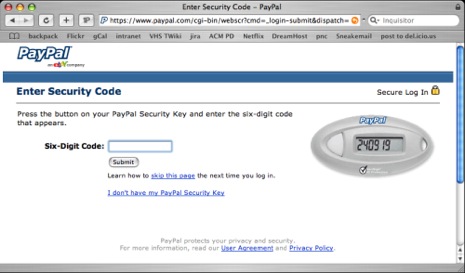
The key worked for me to begin with, but then today both eBay and PayPal started rejecting the PIN I entered. Finally, PayPal made me go through the setup process again, to resync the server to the key's internal clock. Hopefully that won't happen too often. I also tried out the "I don't have my Security Key" option, and it just made me answer the usual security questions, so I'm not sure how much more secure the key is really making my account, but it's an interesting development nonetheless.
.Mac Storage Increase
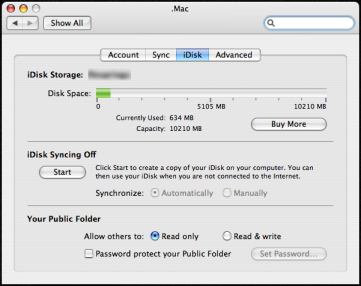
Maybe I will be able to do something with it other than syncing my Keychains and Address Book now. I use Flickr for sharing my photographs, but the new iLife '08 Web Gallery might be useful for sharing movies (I've never had much luck with YouTube: it always seems to end up mangling my videos too much).
ZX81 Nostalgia
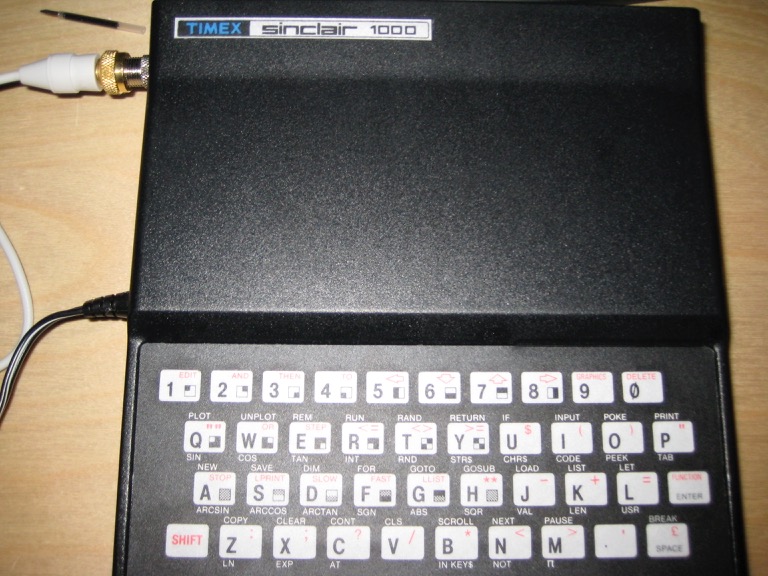
It's been an awfully long time since I've coded in Sinclair BASIC but I threw something quick together:
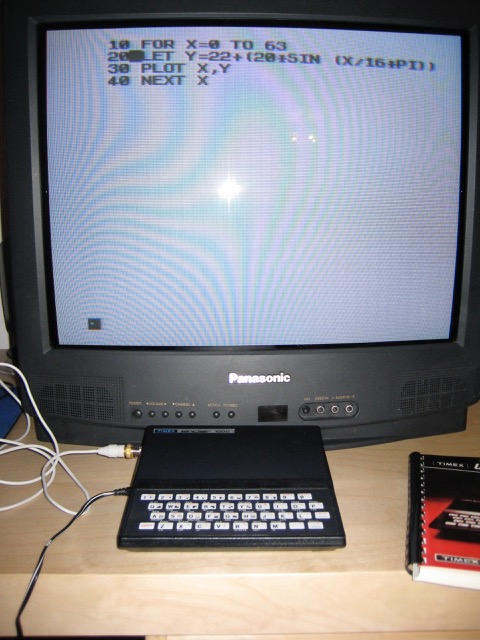
and behold its graphic prowess:
